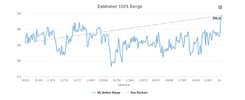I have 2021 Model Y LR that I purchased last December. It now has about 14,000 miles on it. The published range for this car is 326 miles. I noticed recently that when I charge the battery to 100%, the range is shown as 305 miles (94% of the advertised range). I know the car never really gets the full rated range due to weather, weight, hills, and even tricks Tesla does with the EPA estimates, but I recall that when the car was new the gauge would say my range was 326 miles at 100% charge. A Better Route Planner says that my battery has no degradation and has a 75.3 kWh capacity. The calibrated reference consumption is 282 Wh/mi.
We regularly drive to my parent's house, which is a hilly 200 mile drive through NH & VT that we could do without a problem last winter when the car was new. Now this summer if the battery is anywhere less than 90% when we leave, the car will tell us that we will need to stop to charge along the way.
Does anyone know if Tesla has changed the way it calculates range? Is it possible that the car is limiting the min/max charge to improve the battery's lifetime? Or is it possible the battery has degraded and ABRP hasn't detected it yet?
We regularly drive to my parent's house, which is a hilly 200 mile drive through NH & VT that we could do without a problem last winter when the car was new. Now this summer if the battery is anywhere less than 90% when we leave, the car will tell us that we will need to stop to charge along the way.
Does anyone know if Tesla has changed the way it calculates range? Is it possible that the car is limiting the min/max charge to improve the battery's lifetime? Or is it possible the battery has degraded and ABRP hasn't detected it yet?





